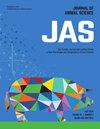提高产后奶牛的遗传增益:在自愿等待期间,用于卵子提取体外胚胎生产的改良卵巢超刺激方案
IF 2.7
2区 农林科学
Q1 AGRICULTURE, DAIRY & ANIMAL SCIENCE
引用次数: 0
摘要
卵巢超刺激取卵(OPU)技术促进了具有优良遗传潜力的动物的快速繁殖,大大缩短了世代之间的间隔。在自愿等待期(VWP)实施OPU的研究是有限的,这是一个有可能最大化高产畜群遗传收益的阶段。我们旨在优化产后奶牛卵泡刺激素(FSH)注射的剂量和频率,以制定OPU-IVF VWP期间卵巢超刺激方案,并评估其对产奶量和生殖性能的影响。超过三个胎次且在305天产奶量的前10%以内的奶牛被选为OPU供体。如果供体奶牛已经完成子宫复旧并且没有宫内感染的迹象,则可以在40天的牛奶(DIM)中开始卵巢超刺激。比较两种超刺激方案:3次注射167 IU FSH (FSH-3组)和5次注射100 IU FSH (FSH-5组)。供体奶牛在DIM 40-75之间进行OPU,然后在人工授精(AI)前等待10 - 15天。共有95头奶牛(113个产蛋期)被分配到FSH-5组,116头奶牛(135个产蛋期)被分配到FSH-3组。将这些供体奶牛在此期间的产奶量和随后的繁殖记录与非供体奶牛的产奶量进行比较。结果显示,FSH-3组效果较好,2 - 6- 6 mm和6-10-mm卵泡较多,总卵泡数较高,卵丘-卵母细胞复合体恢复较好(p<0.05)。此外,FSH-3组产生更多更大级别的卵母细胞,从而更好地产生囊胚(p<0.05)。虽然在VWP期间对供牛应用超刺激- opu延迟了第一次AI的DIM (p<0.05),但它显著提高了受孕率(p<0.05),并且不影响胎次的后续繁殖性能。产奶日产奶量暂时下降,但逐渐恢复。总之,在VWP期间,FSH-3方案平均每头奶牛产生4个以上的胚胎,而不影响生殖性能,包括服务和怀孕率。这些结果表明,FSH-3方案是在VWP期间获得高产奶牛胚胎的有效策略,可以提高遗传增益并加速育种计划,同时对未来的生育影响最小。本文章由计算机程序翻译,如有差异,请以英文原文为准。
Improving genetic gain in postpartum cows: A modified ovarian superstimulation protocol for ovum pick-up-in vitro embryo production during the voluntary waiting period
Ovarian superstimulation-ovum pick-up (OPU) technology facilitates the rapid propagation of animals with excellent genetic potential, substantially shortening the interval between generations. Research regarding OPU implementation during the voluntary waiting period (VWP), a phase with potential for maximizing genetic gains in high-yield herds, is limited. We aimed to optimize the dosage and frequency of follicle-stimulating hormone (FSH) injections in postpartum cows to develop an ovarian superstimulation protocol during the VWP for OPU-IVF and assess its effect on milk production and reproductive performance. Cows with more than three parities and within the top 10% of 305-day milk yield were selected as OPU donors. Donor cows were eligible for ovarian superstimulation starting at 40 days in milk (DIM) if they had completed uterine involution and showed no signs of intrauterine infection. Two superstimulation protocols were compared: three injections of 167 IU FSH (FSH-3 group) and five injections of 100 IU FSH (FSH-5 group). Donor cows underwent OPU between DIM 40–75, followed by a 10–15-day waiting period before artificial insemination (AI). A total of 95 cows (113 OPU sessions) were assigned to the FSH-5 group and 116 cows (135 OPU sessions) to the FSH-3 group. Milk yield data during this period and subsequent reproduction records of these donor cows were compared with those of non-donor cows. The results showed that the FSH-3 group achieved better results, including more 2–6-mm follicles and 6–10-mm follicles, a greater total follicle count, and greater recovery of cumulus-oocyte complexes (p<0.05). Additionally, the FSH-3 group produced more greater-grade oocytes, resulting in better production of blastocysts (p<0.05). Although the application of superstimulation-OPU to donor cows during the VWP delayed the DIM of the first AI (p<0.05), it significantly increased the pregnancy rate (p<0.05) and did not affect the subsequent reproductive performance of the parity. Milk yield temporarily declined on the day of OPU, but it gradually recovered. In summary, the FSH-3 protocol generated an average of more than four embryos per cow during the VWP without compromising reproductive performance, including service and pregnancy rates. These results suggest that the FSH-3 protocol is an effective strategy for obtaining embryos from high-yield cows during the VWP, enhancing genetic gain and accelerating breeding programs with minimal effect on future fertility.
求助全文
通过发布文献求助,成功后即可免费获取论文全文。
去求助
来源期刊

Journal of animal science
农林科学-奶制品与动物科学
CiteScore
4.80
自引率
12.10%
发文量
1589
审稿时长
3 months
期刊介绍:
The Journal of Animal Science (JAS) is the premier journal for animal science and serves as the leading source of new knowledge and perspective in this area. JAS publishes more than 500 fully reviewed research articles, invited reviews, technical notes, and letters to the editor each year.
Articles published in JAS encompass a broad range of research topics in animal production and fundamental aspects of genetics, nutrition, physiology, and preparation and utilization of animal products. Articles typically report research with beef cattle, companion animals, goats, horses, pigs, and sheep; however, studies involving other farm animals, aquatic and wildlife species, and laboratory animal species that address fundamental questions related to livestock and companion animal biology will be considered for publication.
 求助内容:
求助内容: 应助结果提醒方式:
应助结果提醒方式:


